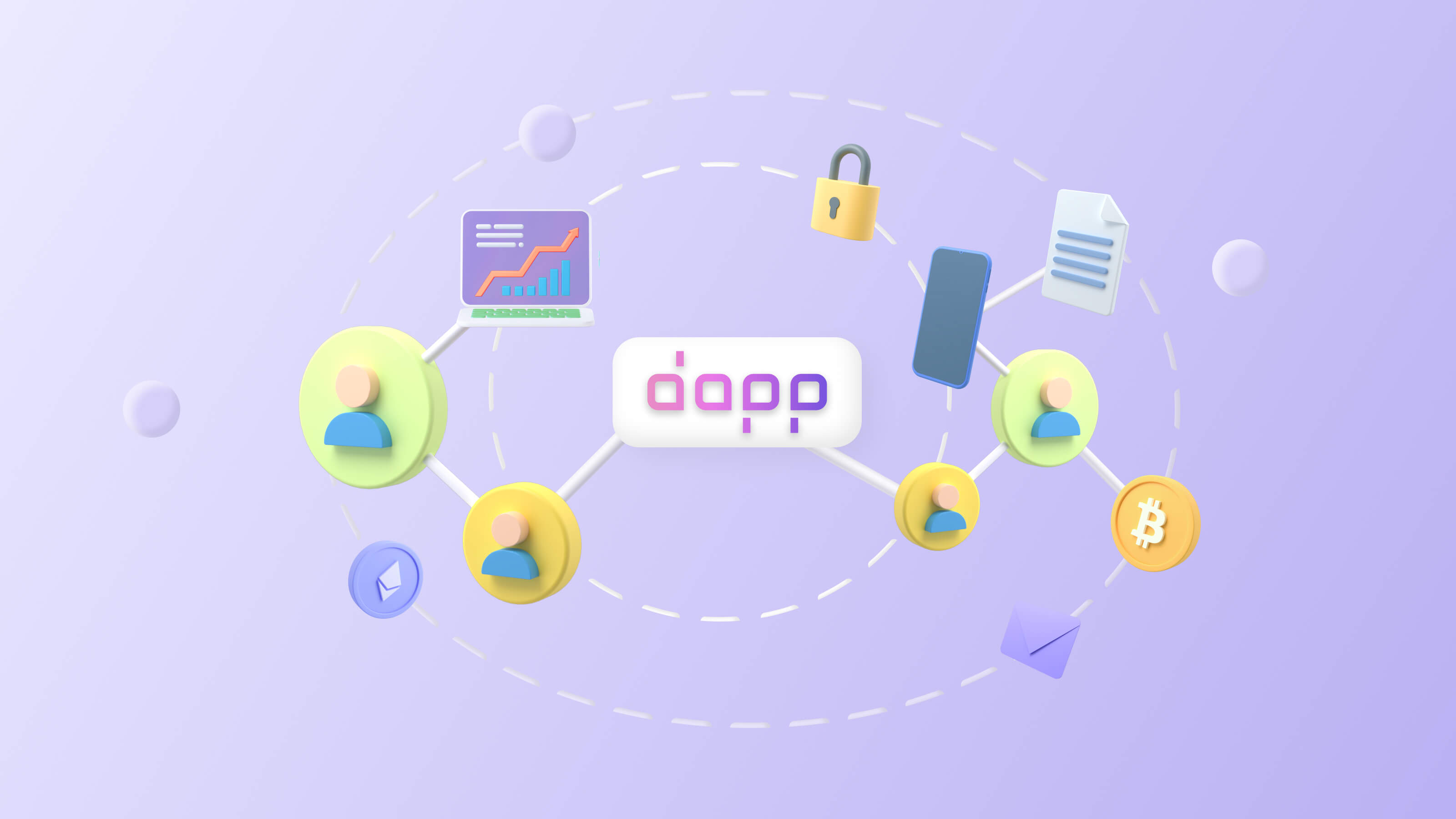Intro
Decentralized apps, or simply called dApps, work on blockchain platforms. DApps avoid centralized servers, so they make transactions using peer-to-peer (P2P) instead of the central HTTP protocol. In two words, DAapp is a mixture of smart contracts, a blockchain, and crypto. Let’s take note that smart contracts are an essential part of any DApp, and they are automated agreements that make transactions between two parties when premeditated terms meet.
- Peer-to-peer, or P2P, means that information is shared between participants. The more participants in the network, the stronger the network. Users provide the computational power to keep the network running. As a reward, they get native tokens of the platform they interact with.
As DApps are a part of a blockchain network, a copy of data is stored on all computers in a blockchain network and could be viewed by the public. So neither individual nor group controls a DApp. Almost all DApps are built on the Ethereum platform, and they can be developed for different purposes, including gaming, finance, medical field, governance, and social media. Needless to say, the Ethereum blockchain supports a wide range of activities across the dApp ecosystem.
All web apps have two components — a frontend that is on your computer and a backend that is on the respective servers. DApp means that the backend component is on the blockchain.
Among the most popular Ethereum based DApps are Open Bazaar, UniSwap, CryptoKitties, Golem, Aave, DYdx, OpenSea, and some non-Ethereum based such as Neo (NEO) and NEM (XEM).
Is It a True DApp?
There are some criteria that help you to understand you’re dealing with a 100% DApp, and not just a web app:
- A true DApp has an open-source code and works without third parties. It must be controlled by a user.
- All information is in a publicly accessible blockchain platform. Decentralization is essential, and there is no central point for attacks.
- DApps have a kind of cryptographic token for access, and they reward contributors such as miners and stakers with native tokens.
- A DApp has a consensus method that generates tokens, such as proof-of-work (PoW) or proof-of-stake (PoW) algorithms.
What Is a Centralized App?
Centralized applications are the most popular, and we’re massively using them now; they are built by developers, governed by a company, and used by the public. If you have Instagram, Twitter, WhatsApp, or Netflix, you have a centralized app on your mobile device, laptop, or PC.
Being a user, you interact with the app by downloading a copy of the app and then sending and receiving data from the company's server. Your personal data is located on a centrally governed database controlled by a company, so you have to trust that this company is not going to sell your data or do anything to harm your interest.

How to Build a DApp
But what if you have an idea to build your own dapp? Actually, the process is not that complicated once you have such an aim. Here are some steps to follow, just our humble advice you can draw attention to if you like:
- You should have a clear and neat understating of your future product — its features, aims, a mechanism, and tokenization plans;
- Install a Node Package Manager that will help you to create open-source codes and files, and Git, which helps in saving and tracking some changes you make with your DApp;
- Pick a stack or a development framework to start with;
- Write your smart contracts or the codes keeping your DApp commands;
- Front-end development with creating UI that would appeal to your potential user;
- Test your raw version of a DApp;
- Distribute native tokens depending on the mechanism that you use;
- Any feedback from your supporting community for making revisions;
- Start achieving your idea step by step while still developing and improving it.
How to Build an App
- Great if you have an accurate idea of your future app and do research of your potential users demands;
- Decide which platform you would like to use — Android or iOS. You can always go further later;
- Use a wireframe mockup that will be only a sketch, a skeleton outline of your app. There are tools like Adobe XD or Figma to help with your app wireframe design;
- Test your wireframe mockup, and get some users feedback to understand if your design is really convenient, enjoyable, and easy to use;
- Choose the app to build it and start the process; Here are some examples: Appy Pie, Zoho Creator, AppSheet, Appian, and alike, or start building your app using popular programming languages like Swift, Kotlin, Java, Objective C, JS, and etc.;
- Final tests, launching, and releasing.
Pros and Cons of DApps
Pros | Cons |
Preoterize user’s privacy | Still experimental |
Censorship free | Not always user-friendly interface |
Flexible that helps to DApp development | Difficult for making code modifications |
Final Thoughts
No doubt, DApps are our future thanks to the transparency, reliability, flexibility, and scalability of the technology. It’s a part of a blockchain, its kid if you want, a kid that grows quite fast. And it feels like in the future all our apps could become decentralized.
If you are a user, you can enjoy the icing of the decentralized platforms cake. If you are a developer, that means you have great room for growth and improvement of your skills. According to the stats, the demand for DApps only gets higher. For example, a videogame Axie Infinity made over 300 million U.S. dollars in August 2021, that’s how DeFi protocols increase in price and value.
